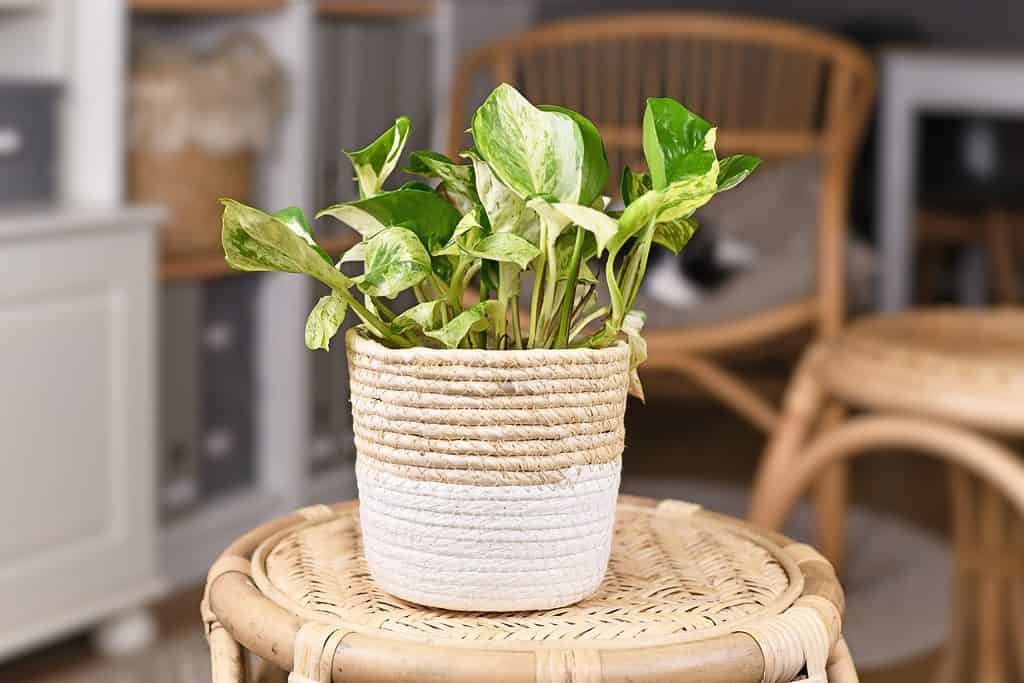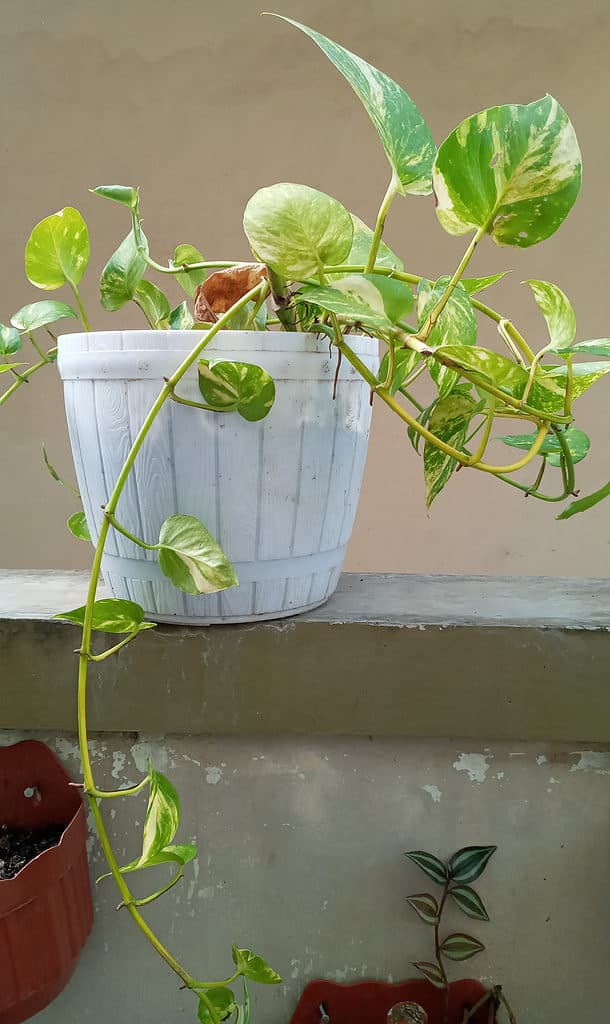The common golden pothos plant is known for its golden-green foliage and long, luscious vines that grow extremely fast indoors. However, in its popularity, many different cultivars and varieties of the golden pothos have been created. And some of the most popular selections are variegated cultivars, or cultivars that have unique patterns on their leaves instead of just a solid gold-green color.
Two of the most beloved variegated pothos in the houseplant market today are the Manjula pothos and the Jessenia pothos. Unfortunately, to the untrained eye, these two varieties can look almost identical. In this article, we’ll explore all of the key differences you need to know to correctly identify a Manjula pothos or a Jessenia pothos, as well as how to care for these stunning variegated beauties.
Comparing Manjula Pothos vs. Jessenia Pothos
| Manjula Pothos | Jessenia Pothos | |
|---|---|---|
| Classification | Epipremnum aureum ‘Manjula’ | Epipremnum aureum ‘Jessenia’ |
| Alternative Names | Happy Leaf Pothos, HANSOTI14 | Devil’s Ivy, Jessenia Ivy |
| Origin | South Pacific Islands, Asia | South Pacific Islands, Asia |
| Description | A patented cultivar of the golden pothos that was developed in India for its delicate white variegation. | A variety or cultivar of the golden pothos that is similar to the marble queen pothos in terms of variegation. |
| Uses | Ornamental | Ornamental |
| Growth Tips | Ensure that your Manjula receives adequate bright, indirect light to keep up its white, vibrant variegation. | Jessenia pothos require a higher than average humidity to really flourish. |
| Interesting Features | The Manjula pothos was created via naturally occurring mutations that took several years and hundreds of plants to execute. | Each leaf of the Jessenia pothos, like most variegated pothos, will have different patterns and even different hues. |
The Key Differences Between Manjula Pothos and Jessenia Pothos
It is worth noting that the Manjula pothos and Jessenia pothos are virtually the same plant. Both share the Epipremnum aureum species. However, they are different varieties with different origins and different coloration and variegation. Just as well, the overall shape of these plants are slightly different.
To start, the shape of these plants’ foliage is different. The Manjula pothos has wider and slightly rounder leaves than the Jessenia pothos. In fact, the leaf shape of the Manjula pothos looks a lot like a philodendron’s leaves. The variegation of the Manjula pothos’ leaves tends to take on a swirling pattern that aligns with the leaf shape. The Jessenia pothos looks very similar in shape and color to the common golden pothos, but its variegation is what gives it away. The Jessenia pothos has golden, light green, and bright green variegation. The Manjula pothos, alternatively, tends to take on a more cream of pale-yellow hue.
The origins of these two plants also differ. The Manjula pothos was developed back in 2010 using a wide range of pothos plants with different gene mutations. The Jessenia pothos was introduced in 2014 by popular online nursery Costa Farms as an offspring variety of the marble queen pothos.
Other than these above differences, these two plants are extremely similar. The best way to tell them apart is their leaf shape and color scheme of their leaves. Other than that, the Manjula pothos and the Jessenia pothos have identical care needs and growing requirements.

The Manjula pothos (pictured) is popular as a houseplant due to its stark white variegation.
©Firn/Shutterstock.com
Manjula Pothos vs. Jessenia Pothos: Classification
The Manjula pothos’ botanical name is Epipremnum aureum ‘Manjula’. The Jessenia pothos’ botanical name is Epipremnum aureum ‘Jessenia’. Both plants are different varieties of the same species. They share the genus Epipremnum, which makes them close relatives of the dragon-tail plant, the silver streak pothos, the rengut plant, and several more.
Manjula Pothos vs. Jessenia Pothos: Description
The Manjula pothos is a cultivar of pothos that has huge, heart-shaped leaves with vibrant white, pale green, and eggshell variegation, which makes it one of the most stunning pothos varieties around. The Manjula pothos is more difficult to find than other varieties because of its rarity. The Manjula pothos is a lovely and low-maintenance addition to any house, but you might need to look into rare plant stores or get in touch with collectors in order to find one that is authentic. Although it is sometimes misattributed to a university in Florida, this cultivar was actually patented by a grower in India. Growing conditions for this plant range from USDA hardiness zones 11 to 12. It can grow up to six feet long indoors.
The Jessenia pothos is one of the most recent pothos varieties to hit the plant market. It looks wonderful practically everywhere because of its tropical appearance and its trailing tendrils. It won’t likely blossom if you plant it inside, though. Heart-shaped waxy leaves, green foliage with pale chartreuse or light green variegation, and extremely long trailing vines are what make the Jessenia pothos distinctive. The Jessenia pothos has been confused for the marble queen pothos in the past, though the marble queen is considerably paler and has finer cream-colored streaks or marbling all over its leaves. In USDA hardiness zones 10 through 12, this cultivar can grow up to 30 feet long outdoors and 10 feet long as a houseplant.
Manjula Pothos vs. Jessenia Pothos: Uses
The Manjula pothos and Jessenia pothos are both used as houseplants. These plants are technically toxic, so they have no place in the culinary world. And while they do have air purification abilities, one cannot really reap the benefits of this ability unless they keep hundreds of pothos plants in their home. So, the only real purpose of the Manjula pothos and Jessenia pothos is to sit there and look pretty.

The Jessenia pothos (pictured) does well as an indoor plant with just a bit of added humidity.
©iStock.com/Bayu SRI TANJUNG
Manjula Pothos vs. Jessenia Pothos: Origin
Pothos plants as a whole are native to the South Pacific Islands and some parts of Asia. They have been naturalized in many tropical places globally, including Puerto Rico, Australia, Hawaii, and Florida.
The Manjula pothos was developed and patented in India by an individual named Ashish Hansoti. The plant was created by breeding over 1,000 different pothos plants with a branch mutation over a handful of years. The result was one of the most variegated pothos varieties available in the market at the time in 2010. Today, the Manjula is still a rare and beloved delight among plant collectors.
The Jessenia pothos’ past is a little more mysterious. The only reputable information on this cultivar’s origins notes that it was introduced to the plant trade and patented by Costa Farms back in 2014. It is also believed that this plant is a cultivar of the popular variegated marble queen pothos.
Manjula Pothos vs. Jessenia Pothos: How to Grow
Manjula pothos and Jessenia pothos have identical care requirements. Both plants need higher humidity than other species to flourish, and both plants also should not be placed in low light lest their beautiful variegation will disappear. The Manjula pothos and Jessenia pothos are well recognized for being resilient and easy to cultivate, like all pothos plants.
These two variegated plants thrive in indirect, bright light. They can, however, also endure mild light rather well. Avoid placing your Jessenia or Marble pothos in dim lighting, since this will diminish the variegation, unlike other pothos varieties. Avoid direct sunlight as well since it will burn the foliage. Manjula pothos require more light than non-white variegated cultivars because of their strong level of variegation, but other than that, their care is very similar to that of the Jessenia pothos.
Jessenia and Manjula pothos, like other species of pothos, prefer to be watered after the top two to three inches of soil have dried up. These plants are well-known for being very drought tolerant and can make it through sporadic neglect and lack of hydration. Cut back on watering during the fall and winter when the plant isn’t actively growing.
The humidity and temperature in a typical home are ideal for these pothos varieties. Nevertheless, if you give them a little additional humidity, their development is more active, so think about growing them in a humid space like a bathroom, laundry room, or kitchen. You might also want to consider setting up a humidifier near the plants. These tropical plants are neither cold nor frost-tolerant, so avoid exposing them to any cold breezes throughout the winter.
In a loamy, well-draining potting mixture, both of these varieties of pothos will grow quite fast. For these pothos, regular indoor potting soil is typically acceptable, but adding extra perlite to improve drainage is usually a good idea. Although constant feeding in the spring and summer helps to keep up good growth and variegation, these pothos do not really need regular fertilization. For the best possible results, try using a balanced water fertilizer once every four weeks through the growing seasons. Do not fertilize either of these plants during the winter.
Although it is not necessary, pruning is typically a smart move to keep growth under control. If you’d want, regular trims can also be used to promote a more robust growth habit. Make sure you have a good set of sterilized, sharp pruning shears or scissors. No more than a third of the plant’s leaves should ever be taken off at once. Like other plants, pothos should be pruned when it is actively growing, which is in the spring or summer. You can use the healthy cuttings from your Jessenia or Manjula pothos for propagation, so save them if you can!
Manjula Pothos vs. Jessenia Pothos: Special Features
The Manjula pothos is unique in that it took nearly 1,000 different plants and genetic mutations to create the variety we know and love today. The Jessenia pothos is also an effort of time and love, believed to have been created through breeding different marble queen pothos plants.
When handled with bare hands, both the Majula pothos and Jessenia pothos plants can irritate the skin and are dangerous if consumed. Although they are not known to be extremely harmful, they can cause vomiting and irritate the lips and tongue. Be mindful to keep the plant out of the reach of little children, pets, and animals. Having said that, regardless of how carelessly you handle the plant, all pothos varieties are the easiest plants to keep. If you do decide to keep either of these varieties, just be careful to keep their fast-growing vines away from curious hands and mouths.
Both of these stunning variegated varieties of pothos would make an excellent addition to any plant collection. And with identical care needs and similar looks, what’s stopping you from keeping both of these plants in your own collection?
Want to learn more about the eye-catching pothos houseplant? Check out our in-depth guide to everything you need to know about pothos!
The photo featured at the top of this post is ©
FAQs (Frequently Asked Questions)
Are Manjula pothos or Jessenia pothos fast growers?
The Jessenia pothos tends to be a bit slower when it comes to growing than the Manjula pothos.
Are Jessenia pothos and Manjula pothos the same plant?
They are the same species, but different varieties.
Are Jessenia pothos and Manjula pothos rare?
Both of these varieties can be a bit difficult to find, but it’s still worth browsing your local nursery or garden center to see if you can find one.
Thank you for reading! Have some feedback for us? Contact the AZ Animals editorial team.







